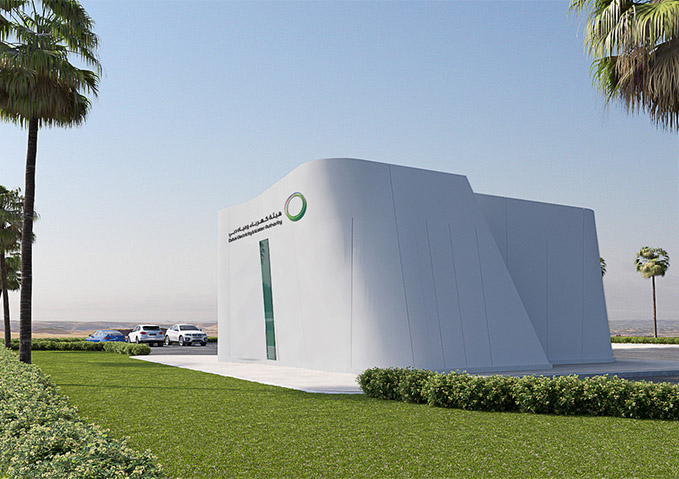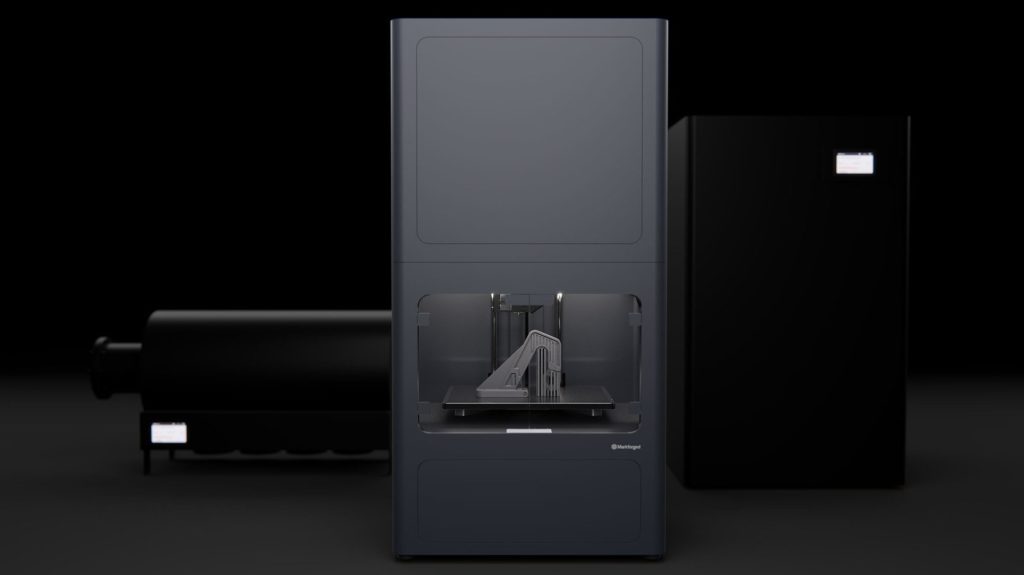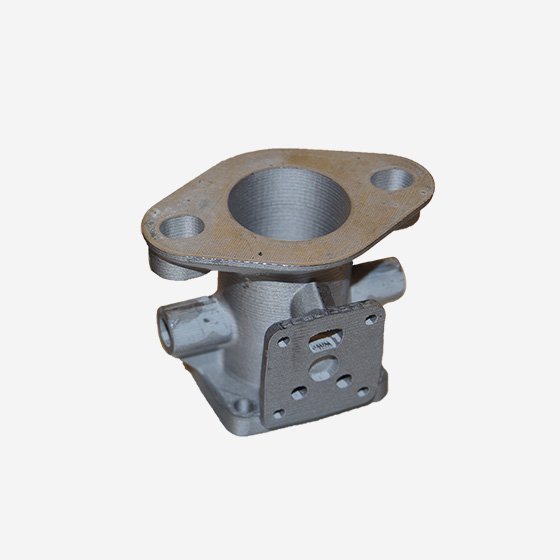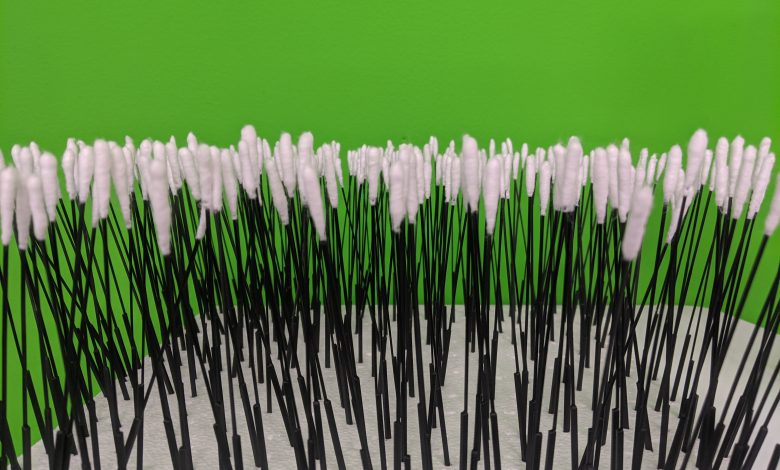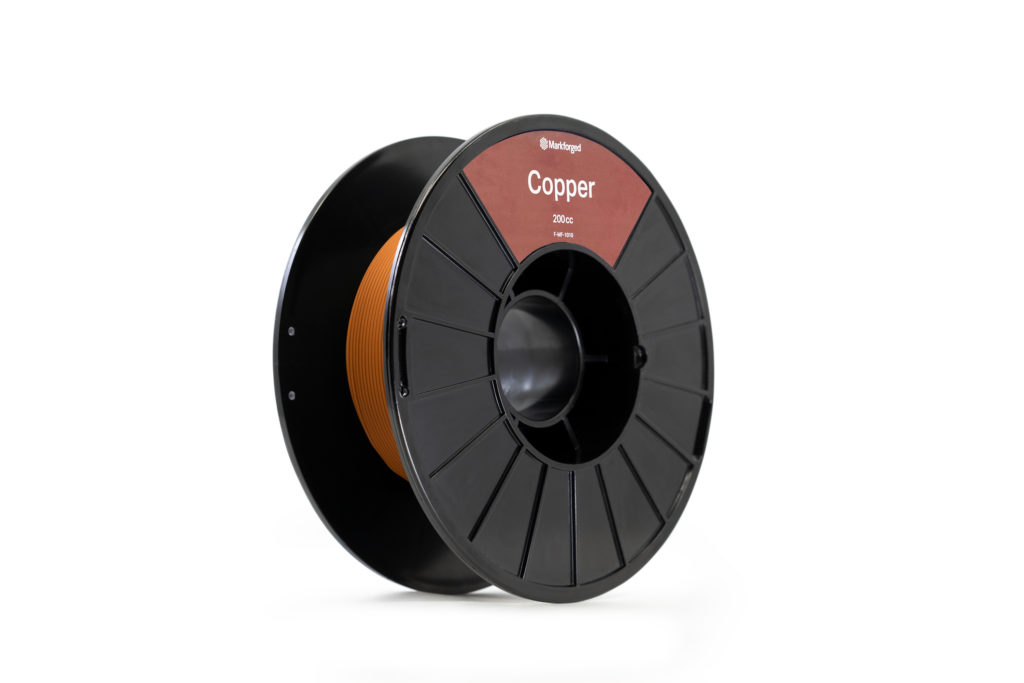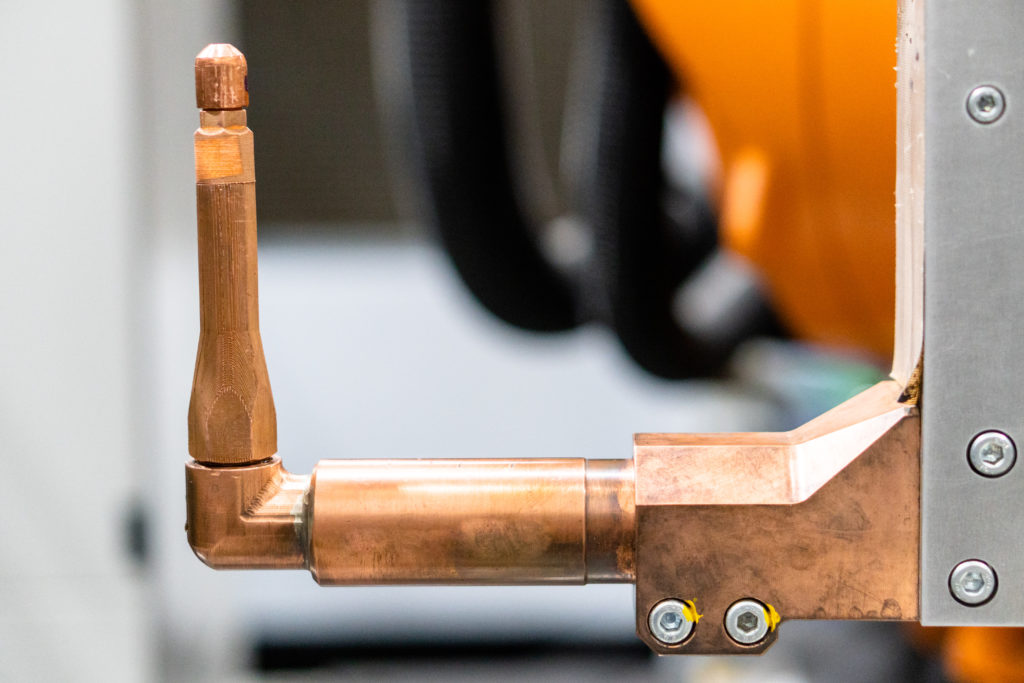Dubai Electrical and Water Authority Deploys Markforged Metal X 3D Printer
Thanks in large part to its ambitious 3D Printing Strategy, the city-state of Dubai, which is the most populous city in the United Arab Emirates (UAE), has used the technology for a wide variety of applications, from mobility and environmental applications to medical and construction, and many of the opportunities and initiatives have come from the Dubai Electricity and Water Authority (DEWA).
DEWA’s vision is to be an innovative, sustainable utility, and uses 3D printing to create both spare parts and prototypes for its distribution, generation, and transmission divisions, as well as to support the digitizing of its inventory. Its Research and Development Center at the Mohammed bin Rashid Al Maktoum Solar Park supports rapid prototyping through 3D printing, in addition to offering mechanical testing, training, techno-economic analysis, and additive manufacturing R&D. Now, DEWA is working to create advanced infrastructure and special AM software through the R&D Center, in order to develop solutions that can increase Dubai’s operational efficiency and productivity.
To that end, it’s the first organization in the Cooperation Council for the Arab States of the Gulf, originally and colloquially referred to as the Gulf Cooperation Council or GCC, to deploy the Metal X 3D printer by Markforged for this purpose.
“The 3D printing programme at DEWA has been selected as one of the Dubai 10X initiative projects. The initiative was launched by His Highness Sheikh Mohammed bin Rashid Al Maktoum, Vice President and Prime Minister of the UAE and Ruler of Dubai, which mandates the Government of Dubai to be a global leader that is 10 years ahead of all other cities,” stated HE Saeed Mohammed Al Tayer, MD & CEO of DEWA, in a press release. “The programme also supports the Dubai 3D Printing Strategy, which is a unique global initiative to use technology for the service of humanity and promote the status of the UAE and Dubai as a global hub for 3D printing technology, by 2030. Our use of the latest Fourth Industrial Revolution technologies and world-class standards aligns with our continuous efforts to improve efficiency in the production, transmission and distribution of energy and water, develop future services and projects that enhance DEWA’s position as one of the best utilities in the world, and enhance Dubai’s leading position globally.”
The Metal X system uses Markforged’s accurate Atomic Diffusion Additive Manufacturing, or ADAM, technology, and is able to print with a variety of metals, such as stainless steel, Inconel 625, and copper. It allows for rapid prototyping, low volume production, and on-demand spare parts 3D printing, all of which will help DEWA increase 3D printing innovation, decrease costs, and improve efficiency.
“We work on innovating and developing new 3D printing facilities across DEWA’s divisions and draft quality procedure protocols. DEWA’s R&D Centre supports 3D printing of components that can endure high temperatures and harsh weather conditions. It includes the latest 3D printing technologies, such as reinforced plastic printers using a mixture of carbon fibre or fibreglass; CYBE printers; and Markforged Metalx metal printers,” Al Tayer explained. “The Centre strengthens DEWA staff’s capabilities in 3D printing, through workshops and training sessions. Besides, it develops the experiences of its engineers and researchers and consolidates their knowledge of additive manufacturing, which supports national capabilities. The number of Emirati researchers at the Centre has reached 70%, including 40 male and female researchers. 20 of whom are PhD and master’s degree holders.”
DEWA’s R&D Center includes DEWA’s Robotics & Drone laboratory, which contains drones and rovers that are designed and built on site. Speaking of on site, the laboratory was the UAE’s first building to be 3D printed completely on site and, according to DEWA, the first 3D printed lab in the world.
(Source: Dubai Electricity and Water Authority)
The post Dubai Electrical and Water Authority Deploys Markforged Metal X 3D Printer appeared first on 3DPrint.com | The Voice of 3D Printing / Additive Manufacturing.
Markforged Metal 3D Printing Replaces Obsolete Part for Legacy Race Car
Founded in 2013 by Greg Mark, Massachusetts-headquartered Markforged quickly became a powerful presence in the 3D printing industry, first with carbon fiber reinforced 3D printing and then developing a novel metal 3D printing technology.
With a range of end-to-end processing systems, Markforged offers its customers access to the boldest advantages in additive manufacturing—not only through rapid prototyping but also rapid speed in the fabrication of high-performance parts. Past the initial investment, industrialists are able to see substantial savings, along with a new ability to innovate upon casting aside the restrictions of older technology. These benefits drew the attention of Tecron, a European company known for its manufacturing and engineering services in the automotive industry.
In a recent case study, the Markforged team details how metal AM processes improved the production of high-performance parts needed for the vintage race cars Tecron has been working on lately. Metal 3D printing offered the opportunity for Tecron to make a shift, especially in working with one of their most important clients, Škoda Motor, to streamline the production of an original, discontinued racecar carburetor.
Tecron’s collaboration with Škoda Motor exemplifies one of the most exciting benefits in 3D printing—offering the ability to create parts that may have become obsolete and are nearly impossible to find. We have followed other projects too within automotive and railways applications, with 3D scanning of original parts allowing for better rebuilding and maintenance.
In the case of the missing design for the carburetor, the original die used in traditional die-casting methods was lost long ago. The Tecron design team not only made an affordable copy of the initial race-car component, but they also modified the structure for better optimization.
In another study, Czech Aerospace Research Centre (VZLU) partnered with Tecron for prototyping and testing new parts. Engineers were tasked with creating a new wing design and challenged with finding a method that was not cost-prohibitive. Prototyping can require extensive (and expensive) measures for applications like aerospace, and VZLU realized the need for different, advanced technology in creating complex models like their innovative nozzle design.
“The narrow slit in the design improves overall wing performance, and was crucial to the success of the process. Deconstructing the design into several more manageable parts would have a negative impact on performance,” stated the Markforged case study.
The use of electrical discharge manufacturing (EDM) was another possible choice, but was not cost-effective and would have taken much longer than with metal 3D printing. In using the Metal X by Markforged, the engineers were able to complete their highly customized design, quickly and affordably.
After analyzing over 100 additive use cases, Markforged discovered that industrial users are concerned with the following:
- Accessibility
- Design freedom
- Physical strength and durability
- Reliability
Data was compiled from the 2020 Additive Trends Report by Markforged, also showing that 46 percent of companies expect to be using additive manufacturing within the next two years. Download the study here.
[Source / Images: Markforged]
The post Markforged Metal 3D Printing Replaces Obsolete Part for Legacy Race Car appeared first on 3DPrint.com | The Voice of 3D Printing / Additive Manufacturing.
3D Printing and COVID-19, April 9, 2020 Update
Companies, organizations, and individuals continue to attempt to lend support to the COVID-19 pandemic supply effort. We will be providing regular updates about these initiatives where necessary in an attempt to ensure that the 3D printing community is aware of what is being done, what can be done and what shouldn’t be done to provide coronavirus aid.
Established AM service provider, FIT Additive Manufacturing Group, has developed a filter-carrying mask for the general public. The mask is made up of two pieces, a 3D-printed mask and a disposable filter. While the 3D-printed component can be easily disinfected, the filter can be made from just about any cloth material, such as a paper towel or tissue paper, which can then be swapped out and disposed of quickly. According to a study by the University of Cambridge, a vacuum cleaner bag exhibits the performance characteristics most similar to surgical masks.
Given the fact that the Centers for Disease Control is now recommending that the general public wear cloth masks, this may be a suitable method of creating one, while freeing up respirators and surgical masks for medical workers. The president of the German Medical Association too called for the wearing of protective masks. FIT is currently designing a smaller model specifically for children. The file for the existing version, optimized for selective laser sintering, can be found here.
Markforged is the latest company to jump into 3D printing nasal swabs, alongside Carbon, Formlabs, EnvisionTEC and HP. Working with Neurophotometrics, the additive manufacturing (AM) startup is 3D printing 10,000 swabs daily with plans to scale to 100,000 daily. The partners are working with the San Diego Covid Research Enterprise Network (SCREEN) Initiative to manufacture the tools, made with base of 3D-printed nylon and a tip of wrapped rayon.
The group has tested the nasal swabs with 50 volunteers, with patients who tested positive for COVID-19 re-tested three to 14 days later with both commercially available swabs and 3D-printed counterparts. According to Markforged, the commercial swab detected the virus in most but not all of the patients, but all of the 3D-printed swabs came back positive. This indicates the possibility that the 3D-printed swabs may be more effective at collecting viral particles and reduce the rate of false negatives (albeit with an extremely small sample).
Upon completing clinical validation with the institutional review board at Rady Children’s Hospital and the University of California San Diego, Rady Children’s has ordered 30,000 swabs. The swabs are being sold at the Neurophotometrics website. As discussed in yesterday’s update, nasal swabs are in short supply to perform COVID-19 tests; however, they are only one part of the problem. There is also a lack of testing equipment, reagents, and trained staff to process tests.
Metal powder bed fusion (PBF) systems manufacturer SLM Solutions launched a coalition directed toward rapidly producing parts needed for COVID-19 medical supply efforts. The Additive Alliance Against Corona is aimed at leveraging machines and processes already certified to current European “Medical Device Regulation” and ISO 13485 guidelines to make medical parts and tooling for medical parts. According to the company, SLM metal PBF 3D printers in the U.S. are already being used to manufacture metal injection molding tools to produce face shields. Companies that can lend their support are invited to join the coalition via SLM’s dedicated webpage.
GE continues to produce personal protection equipment (PPE), specifically face shields, which can help extend the lifespan of the N95 respirators beneath said shields. GE Additive has designed a 3D-printed adapter that converts a standard hard had and visor into a face shield.
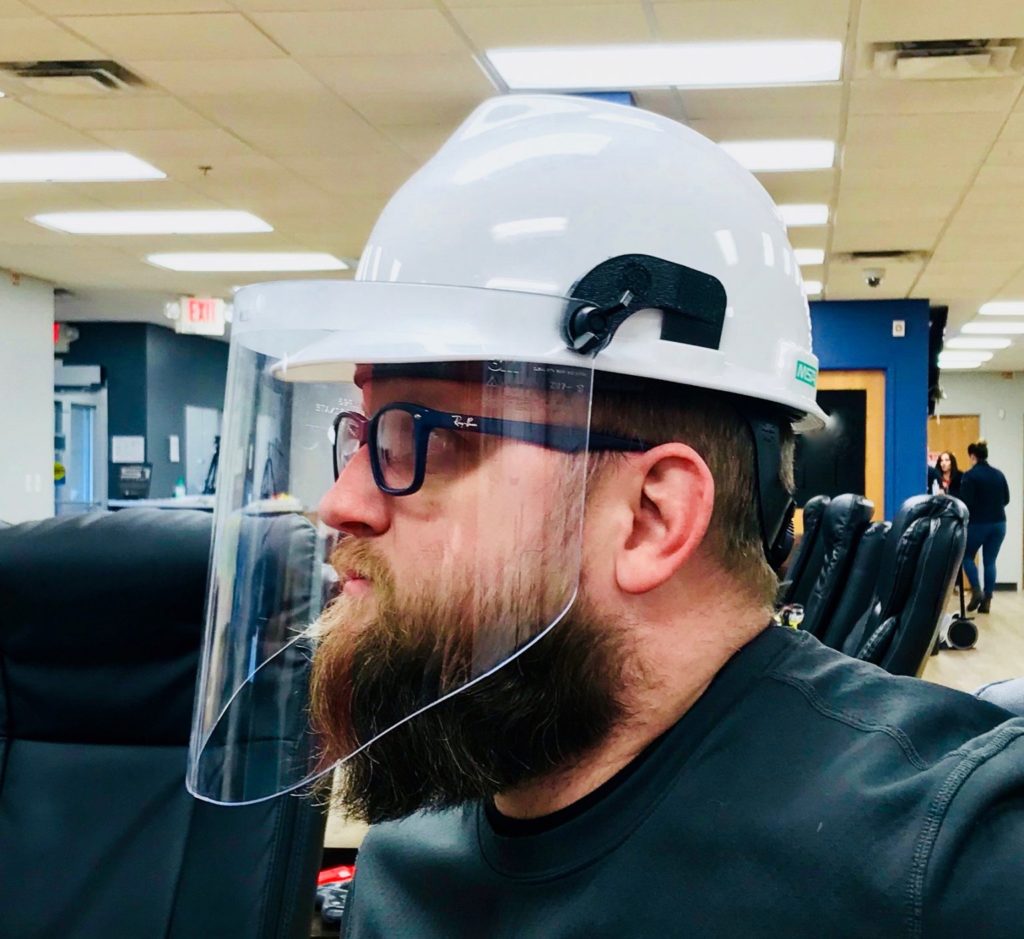
A face shield made with a 3D-printed adapter and a standard hard hat. Image courtesy of GE Additive.
Due to the fact that hard hats have lateral and frontal tabs above the rim for mounting accessories, GE’s solution is a simple one. The adapter fits into the lateral tab of a standard hard hat and features a twist bolt that grabs onto the visor. The visor can also be easily raised and lowered. The adapter is 3D printed on fused deposition modeling systems from ABS plastic. There have been some reported issues with autoclaving 3D printed ABS with parts failing sterilization or warping during the process during both flash and regular autoclave. The company has provided the file online and suggests that any hobbyist system can print it.
Interestingly, the design introduces another element that is dependent on the currently disrupted supply chain: finding hard hats. GE’s partner in the endeavor, TriHealth, reached out to an industrial supply company for the accompanying hard hats.
As mentioned in our interview with Dr. Beth Ripley, Director of the VA 3D Printing Network in the VHA Innovation Ecosystem, 3D printing is currently acting as a stopgap solution for rapidly producing necessary medical supplies until mass manufacturing can produce parts in larger quantities more quickly.
In this case, GE Additive is providing a stopgap in the PPE supply chain while only partially ramping up production in the ventilator supply chain. GE Healthcare has quadrupled ventilator production at its Madison, Wis. location, but GE Aerospace has laid off employees due to financial issues caused by the COVID-19 outbreak as its own aerospace workers demanded the production of jet engines be redirected toward supporting GE Healthcare’s ventilator operations.
As the pandemic continues to grip the world, we will continue to provide regular updates about what the 3D printing community is doing in response. As always, it is important to keep safety in mind, remain critical about the potential marketing and financial interests behind seemingly good humanitarian efforts from businesses, and to do no harm.
The post 3D Printing and COVID-19, April 9, 2020 Update appeared first on 3DPrint.com | The Voice of 3D Printing / Additive Manufacturing.
German Giant Würth Group Offers Markforged 3D Printing Services
Würth Industry of North America (WINA) has announced that it will distribute Markforged 3D printing products to its customers throughout the general manufacturing, oil & gas, heavy equipment and transportation markets. The agreement further secures the place of Markforged within the general manufacturing segment, as well as introduces a large German company to the additive manufacturing (AM) sector.
WINA is the North American subsidiary of the Würth Group, one of Germany’s largest private companies, with annual revenues of €14.27 billion in 2019, over 78,000 employees and over 400 companies in 86 countries. The group is a wholesaler of a variety of products ranging from fasteners, safety equipment and maintenance repair and operational items to chemicals, electronic and electromechanical components, inventory management, storage and retrieval systems. WINA itself is valued by the group at $1 billion.

From left to right, Dan Hill, Chief Executive Officer for Würth Industry North America and Greg Mark, CEO and founder of Markforged. Image courtesy of Würth Industry North America.
Through the partnership, Würth will provide metal and composite 3D printing services and parts, as well as digital Kanban solutions for inventory management. In the case of the former, WINA will use such Markforged technologies as its bound metal deposition and Continuous Filament Fabrication for 3D printing metal parts and polymer parts reinforced with materials such as carbon fiber, fiberglass and Kevlar.
As for the latter, Würth provides its CPS KANBAN service brand to manage warehouse and production operations using patented bins and RFID technology. Markforged 3D printing technology will be integrated such that customers can reduce their physical inventory.
Dan Hill, chief executive officer for Würth Industry North America, put it this way: “By integrating Markforged 3D Printing technology with our existing kanban programs, we are able to offer quicker time to market and lower inventory costs. We’re able to cut out the sourcing, purchasing, and transportation costs and deliver the value directly to the customer.”
The partnership is a significant one for understanding the growth and direction of AM in the general industry and tooling segment, as well as the other markets that Würth serves. SmarTech Analysis projects that AM for this sector will result in $5.48 billion in total revenue by 2029 due to the number of large companies like Würth understanding the opportunities the technology presents for general industry and tooling businesses.
The services sub-segment is a particularly interesting one to watch. As mentioned in our recent story on SmarTech’s general industry and tooling report, a number of unique companies are now involved in providing 3D printing services, beyond your household names (Materialise, Stratasys, 3D Systems, etc.). Sandvik, Parmatech, Kennametal, Phoenix Contact, GKN Additive and SMS Group all have specialty offerings. Whereas Sandvik and Kennametal are focused on 3D printing with their own metal powders, GKN and Parmatech are offering HP’s Metal Jet. GKN also provides copper 3D printing services, alongside other metal powder bed fusion printing technologies. Phoenix Contact and SMS Group have their own specialized services. Now, the Würth Group is providing bound metal deposition and composite 3D printing, two very different technologies.
Given its size and established role in this space, Würth may play an important role in broader adoption of AM within general industry and tooling, which will also bleed into other verticals in which the company operates. For instance, it has worked with a wide range of motorsports teams in a variety of series, including Formula One, Formula E, DTM, NASCAR and V8 Supercars. Motorsports is both an area where 3D printing thrives, due to its ability to produce small numbers of specialty, high-performance parts, and an area in which Markforged has a great deal of experience, given founder Greg Mark’s prior history in the industry.
While the group will continue its work in the still profitable oil and gas segment, current disruptions in oil prices indicate that Würth’s moves to invest in solar energy will become increasingly valuable. In 2006, it opened a plant dedicated to new types of solar cells that use copper, indium and selenium instead of silicon. It will be interesting to see how Markforged 3D printing technology, including pure copper 3D printing, will be utilized in these sectors, as well.
The post German Giant Würth Group Offers Markforged 3D Printing Services appeared first on 3DPrint.com | The Voice of 3D Printing / Additive Manufacturing.
Markforged receives undisclosed investment from military-supporting nonprofit
CIA’s In-Q-Tel Invests in Markforged
Boston-based startup Markforged is growing rapidly, pulling in a whopping $82 million investment in March 2019. Now, the 3D printer manufacturer is getting some additional funds, though this time the amount won’t be disclosed because it comes from the highly secretive In-Q-Tel, Inc., the venture capital arm of the CIA.
Markforged announced that is has signed a strategic investment agreement with In-Q-Tel. The investment company, launched by the CIA in 1999, is involved with (sometimes controversial) projects across the government intelligence and security community. As we discussed in our series on In-Q-Tel, the company does not usually make public how much it invests in startups nor the specific role that it plays with those firms in which it invests.
However, our research suggested that average funds range between $500,000 to $3 million in exchange for equity in the company and an advisory role on the startup’s board. This allows In-Q-Tel to potentially guide product development and learn of any news before the public does.

Quincy Reynolds with the Metal X 3D printer at Camp Kinser in Okinawa, Japan. Image courtesy of Matthew M. Burke/Stars and Stripes.
While Markforged has seen its technology deployed across a variety of industrial sectors, its low-cost metal 3D printing and fiber reinforcement systems have had strong success in the military and weapons sectors. According to the company, the U.S. military has hundreds of Markforged machines in operation, including the “first forward-deployed metal system to support combat operations and now has expanded its support operations to three continents.”
Given the sheer size of the U.S. military, it has funds to explore a wide range of 3D printing applications. Specifically, the III Marine Expeditionary Force is using the Metal X 3D printer as part of its repair services for U.S. occupation in the Asia-Pacific region. Having already worked with the U.S. military, then, it seems natural that Markforged would accept an investment from In-Q-Tel.
In-Q-Tel’s interest in Markforged also seems natural, as the investment vehicle has already provided funds for other startups in the space, including Voxel8, Fuel3D and Arevo. In particular, Arevo develops continuous carbon fiber 3D printing technology, though of a different variety than Markforged’s. Whereas Markforged has so far only released desktop-sized systems capable of continuous fiber reinforcement 3D printing, Arevo is focused on machines capable of printing entire bicycle frames. Moreover, Arevo uses a laser-mounted robotic arm to deposit pre-impregnated fiber reinforcement, while the Markforged process is more akin to traditional desktop FDM/FFF 3D printing.
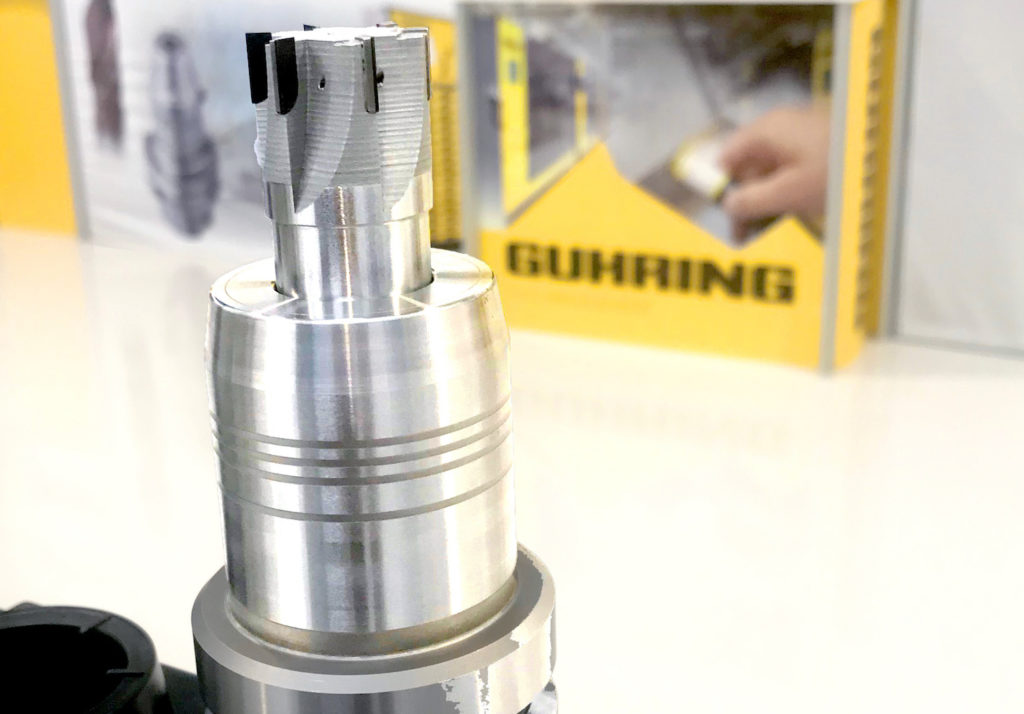
Guhring UK’s 3D-printed metal tools have been sent to customers for testing new concepts. Image courtesy of Markforged.
The news comes on the heels of other exciting stories from Markforged, that include the recent release of pure copper for Metal X and the use of Metal X for 3D printing custom cutting tools for Guhring UK. At the beginning of February, Markforged became the first and, so far, only AM company to receive the ISO/IEC 27001 security certification, international standards signifying the ability of the company to ensure privacy, confidentiality, integrity, and availability across its product line. This includes its Eiger cloud printing platform, hardware, fleet management software, and information governance policies. Surely the startup was pursuing the certification ahead of its investment by In-Q-Tel, but it likely doesn’t hurt any interest the U.S. intelligence community might have had in Markforged.
The post CIA’s In-Q-Tel Invests in Markforged appeared first on 3DPrint.com | The Voice of 3D Printing / Additive Manufacturing.
The 3D Printing Industry news bulletin
Markforged Introduces Pure 3D Printable Copper
Markforged has announced the release of a new metal material for its Metal X 3D printer: copper. Due to the comparatively low-cost of the Metal X system, this makes Markforged technology the most affordable method for 3D printing copper in the industry.
Copper has some very niche uses, mostly associated with its great thermal and electrical conductivity; however, due to its high reflectivity, copper is extremely difficult to work using laser-based metal 3D printing systems. As a result, the industry has often relied on copper alloys to tone down the metal’s luster. In cases where pure copper is 3D printable, the systems that can process (EBM from GE Additive and DED from Optomec) it are typically quite expensive.
The Metal X system is one of two low-cost machines that 3D print metal using bound metal deposition (BMD) technology: depositing metal-bound plastic filament to create green parts that must be washed in a debinding station and then sintered in a furnace. This brings down the cost of the complete package (including post-processing equipment) to about $100,000 to $160,000. The materials themselves are meant to be lower cost as well, as they are usually metal powders from the much larger metal injection molding (MIM) industry that have been qualified for the BMD process.
Additionally, because the initial deposition process relies on technology similar to desktop FDM 3D printers, it is much easier than metal powder bed fusion (PBF) systems. While the post-processing steps may seem burdensome to the uninitiated, they are common in MIM and the printer itself is likely to be a lot safer and less complicated than PBF.
The ability to print with copper at a lower cost can be useful in applications that require high thermal or electrical conductivity. While NASA is 3D printing copper for rocket engines, more common and smaller uses in industrial manufacturing include induction coils. Induction heating relies on passing electromagnetic currents through conductive metal elements for the purpose of generating heat. This highly controllable process is used in such applications as welding, brazing, forging, cooking and injection molding.
As it stands, traditionally made copper inductor coils have relatively short lifespans as joints between welded elements experience repeated stress every time they are heated and cooled. Several firms in the 3D printing space (the GH Group, GKN Additive and PROTIQ, to name a few) have learned that 3D printing copper induction coils can increase the lifespan of the parts by two to three times, while also opening up new design possibilities thanks to the geometric complexity allowed with 3D printing.
In the automotive industry, copper is used for spot welding; however, having parts made for welding jobs can take months and cost thousands of dollars. Markforged demonstrated the utility of its new material to make spot welding parts for a large automotive manufacturer.
The auto company tested how copper shanks made using the Metal X would hold up while performing typical welding operations. The company found that the 3D-printed shanks performed just as well and showed the same resistance as traditionally made counterparts. Moreover, they believe that using the 3D-printed components could reduce lead times by 12 times and part costs by six. As a result, the company plans to introduce the parts to the production line.
The maintenance manager of the automotive manufacturer was quoted as saying, “[O]ur experience with 3D printed copper has been incredible – especially when looking at its conductivity and structural stability. And now that we’ve successfully evaluated weld testing, we plan on expanding our metal 3D printing capacity for this and other metal components. 3D printing copper with Markforged is faster and more cost effective than purchasing complex machined components, and we expect it to help us mitigate downtime exposure and reduce inventory costs by $200,000 a year using only one Metal X system.”
The latest material from Markforged is a useful indicator of the rapidly evolving metal 3D printing space, which is seeing new materials qualified for metal 3D printing processes at an exciting pace thanks in part to bound metal printing technologies like Metal X. As binder jetting systems from HP and Desktop Metal begin entering the marketplace, the larger manufacturing industry will begin changing in ways we may not have even predicted.
The post Markforged Introduces Pure 3D Printable Copper appeared first on 3DPrint.com | The Voice of 3D Printing / Additive Manufacturing.
Metal X 3D Printer Begins Operations at U.S. Military Base
Markforged can happily claim to be a pioneer on a number of fronts in the additive manufacturing (AM) industry: 3D printing reinforcement fibers, low-cost metal 3D printing, unique quality control systems, software and more. While there are surely other new technologies on the horizon for the Boston-based startup, the most exciting offering from the company at the moment may be its metal 3D printing system, Metal X.
Demonstrating the capabilities of the Metal X, the U.S. military recently showed off its new Metal X system in a story for Stars and Stripes. In December, III Marine Expeditionary Force (III MEF) began running a Metal X system at its 3rd Maintenance Battalion shop at Camp Kinser one of the U.S.’s highly controversial military bases on the island of Okinawa.
The shop is staffed by 12 marines who repair parts for U.S. weapon systems and vehicles for all III MEF units, which occupy numerous bases across the small, Japanese island, as well as several bases on the larger island of Honshu and additional locations in South Korea and Hawaii. Typically, the crew has had to rely on CNC machines to make parts. As our readers know, this process can be costly, time consuming, and wasteful of material.

Quincy Reynolds with the Metal X 3D printer at Camp Kinser in Okinawa, Japan. Image courtesy of Matthew M. Burke/Stars and Stripes.
While the shop has had plastic 3D printers for the past four or five years, they have typically been reserved for prototyping. The Metal X system will make it possible for the military to 3D print metal end parts on demand. So far, these parts have included gauges for .50-caliber machine guns, sockets for wrenches and a piece to test weapon optics at the armory.
The Metal X extrudes metal powders bound together in a polymer matrix in a method similar to the traditional fused deposition modeling associated with desktop 3D printing. These “green” parts are then placed into a debinding station in which liquid argon washes away the plastic binder. The now “brown” parts are then placed into a furnace which sinters the metal parts for up to 27 hours and up to 1482°C, resulting in solid metal parts.
“Whereas with our new metal 3D printer, that opens up a whole new world for us,” shop foreman Staff Sgt. Quincy Reynolds said. “This piece of equipment is able to save time with the multiple prints and then you’re able to have a completed [piece] … that does not need any machining.”
Whereas a marine might spend eight to 12 hours machining a single component, the metal 3D printer can produce multiple parts at once. Once the initial layers are printed successfully, the solider can move on to other activities. In turn, one user can work on four projects at a time. Because the furnace the staff is using only holds about half the capacity that the Metal X can print, the shop will be upgrading to a larger furnace.
“We’re asking units, ‘Hey, just give us a problem. Let us figure out the solution for you,’” Reynolds said. “Right now, the sky is the limit honestly with this printer. If you can think of it, we can literally do it.”

A .50 caliber machine gun gauge 3D printed by the U.S. military forces in Okinawa using the Metal X 3D printer. Image courtesy of Matthew M. Burke/Stars and Stripes.
From the description provided in Stars and Stirpes, the Metal X system is delivering on an endeavor that the U.S. military has long been pursuing: the ability to 3D print metal components on demand. The long-term goal for the military is to be able to make parts as close to a warzone as possible, potentially within portable fablabs.
Because the U.S. spends more on its military than the next seven countries combined, it has the expenses to research these cutting-edge initiatives and more. As the largest military force in the world (coincidentally also the largest polluter), the U.S. is under a seemingly constant need to develop its capability versus others that might challenge its hegemony. It has garrisoned the planet with over 1,000 military bases located in 80 countries, representing 95 percent of the globe’s total military installations (for comparison France, the U.K. and Russia have about 10-20 foreign outposts each and China has one).
As a result, the U.S. military is exploring a wide range of experimental 3D printing applications. Others include 3D printing meals for soldiers, 3D-printed grenade launchers, 3D-printed ship hulls, skin 3D printers for rapidly healing wounds.
The post Metal X 3D Printer Begins Operations at U.S. Military Base appeared first on 3DPrint.com | The Voice of 3D Printing / Additive Manufacturing.


